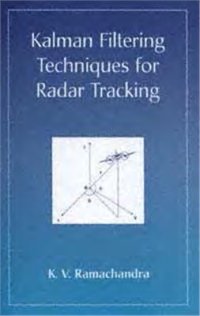
Ebook: Kalman Filtering Techniques for Radar Tracking
Author: Ramachandra K.V.
- Genre: Mathematics // Wavelets and signal processing
- Tags: Приборостроение, Обработка сигналов
- Language: English
- pdf
Издательство Marcel Dekker, 2000, -252 pp.The Kalman filter theory published in 1960 significantly boosted the development of sophisticated digital filter algorithms for tracking space vehicles. As a result, a large number of tracking filters have been developed and their algorithms published in journals.
Tracking of objects based on Kalman filter theory has become an established technique of fundamental importance in both engineering applications and scientific investigations. The central problem is that radar and sonar systems, optical telescopes, and infrared sensors used in civil and defense applications require updated information obtained continuously on the parameters that describe the dynamics of such targets as satellites, missiles, aircraft, ships, submarines, RPVs, and other objects having a significant relative motion with respect to the sensor.
Recent developments such as track-while-scan systems, phased array radar tracking, airborne radar tracking, multitarget tracking, multisensor tracking, and multitarget multisensor tracking have not only increased the scope of tracking technology but also added new dimensions to it. Specifically, the position of a target such as an aircraft or similar vehicle is measured at discrete intervals of time by an automatic track-while-scan radar sensor, and the measurements are reported to a radar data processor (RDP).The reports obtained from successive radar scans are processed by the RDP and suitable tracks are formed.
A computer tracking filter is used to smooth the report data corrupted by range noise and angular noise caused by the electronic and mechanical components of the measuring device.
The tracking filter is the most important component of an RDP/ surveillance system. It processes the target radar measurements, reduces the measurement errors, estimates the position, velocity, and/or acceleration of the target at any instant of time, and predicts the future position of the target. Hence the tracking filter is the heart and soul of a radar data processing system.
This book deals with the development of different types of tracking filters based on the Kalman filtering techniques for radar tracking applications.Kalman Filter
Discrete-Time One-Dimensional Tracking Filters
Discrete-Time Two-Dimensional Tracking Filters
Discrete-Time Three-Dimensional Tracking Filters
Continuous-Time One-Dimensional Tracking Filters with Position Measurements
Continuous-Discrete-Time One-Dimensional Tracking Filters with Position Measurements
Continuous-Discrete-Time One-Dimensional Tracking Filters with Position and Rate Measurements
Continuous-Time One-Dimensional KalmanTracking Filters with Position and Velocity Measurements
Maneuvering Target Tracking
Tracking a Maneuvering Target in Clutter
Introduction to Multitarget Tracking
Tracking of objects based on Kalman filter theory has become an established technique of fundamental importance in both engineering applications and scientific investigations. The central problem is that radar and sonar systems, optical telescopes, and infrared sensors used in civil and defense applications require updated information obtained continuously on the parameters that describe the dynamics of such targets as satellites, missiles, aircraft, ships, submarines, RPVs, and other objects having a significant relative motion with respect to the sensor.
Recent developments such as track-while-scan systems, phased array radar tracking, airborne radar tracking, multitarget tracking, multisensor tracking, and multitarget multisensor tracking have not only increased the scope of tracking technology but also added new dimensions to it. Specifically, the position of a target such as an aircraft or similar vehicle is measured at discrete intervals of time by an automatic track-while-scan radar sensor, and the measurements are reported to a radar data processor (RDP).The reports obtained from successive radar scans are processed by the RDP and suitable tracks are formed.
A computer tracking filter is used to smooth the report data corrupted by range noise and angular noise caused by the electronic and mechanical components of the measuring device.
The tracking filter is the most important component of an RDP/ surveillance system. It processes the target radar measurements, reduces the measurement errors, estimates the position, velocity, and/or acceleration of the target at any instant of time, and predicts the future position of the target. Hence the tracking filter is the heart and soul of a radar data processing system.
This book deals with the development of different types of tracking filters based on the Kalman filtering techniques for radar tracking applications.Kalman Filter
Discrete-Time One-Dimensional Tracking Filters
Discrete-Time Two-Dimensional Tracking Filters
Discrete-Time Three-Dimensional Tracking Filters
Continuous-Time One-Dimensional Tracking Filters with Position Measurements
Continuous-Discrete-Time One-Dimensional Tracking Filters with Position Measurements
Continuous-Discrete-Time One-Dimensional Tracking Filters with Position and Rate Measurements
Continuous-Time One-Dimensional KalmanTracking Filters with Position and Velocity Measurements
Maneuvering Target Tracking
Tracking a Maneuvering Target in Clutter
Introduction to Multitarget Tracking
Download the book Kalman Filtering Techniques for Radar Tracking for free or read online
Continue reading on any device:

Last viewed books
Related books
{related-news}
Comments (0)